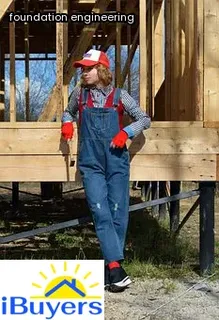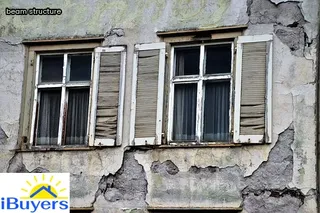Leveling your house foundation is essential for preventing settling issues and maintaining structural integrity. Doing so can help to protect your home from damage caused by shifting foundations, which can lead to costly repairs and even complete rebuilds.
It also helps to ensure that all internal and external doors open and close properly, as well as keeping windows from sticking or becoming difficult to open due to a misaligned frame. Moreover, effective house leveling can provide peace of mind knowing that the structure of your home is stable and secure.
This can be especially beneficial in areas prone to extreme weather like heavy rains, floods, and earthquakes which can cause further settling or shifting of the foundation resulting in serious damage if left unchecked. In addition, leveling your house foundation may also lower your energy bills by providing insulation against outside temperatures.
Furthermore, it can help reduce noise pollution by blocking sound waves from entering through windows or other cracks in the walls caused by settling of the home’s foundation. Ultimately, these are just some of the many benefits associated with effectively leveling your house foundation in order to prevent settling issues.

House leveling is a process that can save homeowners a lot of time and money in the long run by preventing settling issues. It involves the use of specialized equipment to check for unevenness in the foundation and then adjusting it as needed to make sure it's level.
The process usually starts with an evaluation to determine how severe the issue is and whether it needs to be addressed at all. Next, the installer will use a laser level or other tools to measure unevenness and then make adjustments accordingly.
In some cases, this may involve adding additional support beams or shims beneath the foundation in order to provide stability and ensure that no further settling takes place. Finally, all of this work should be checked regularly over time in order to identify any new issues that may arise due to shifting soil or other environmental factors.
By taking these steps, homeowners can help keep their house foundation level and prevent costly repairs down the road.
The cost associated with house leveling can vary greatly depending on the size of the foundation, the severity of the issue, and the type of structure being leveled. The amount of work involved in leveling a house foundation is influenced by access to the area; if it is difficult to reach or requires special equipment, labor costs may be higher.
The age and condition of a house can also affect the cost of leveling; if an older home has an unleveled foundation that has been neglected for years, it could require more extensive repairs than a newer home with a recently noticed issue. Additionally, if there are other underlying issues such as drainage problems or structural damage that must be addressed first, this could further increase the cost.
The most important factor in determining the overall cost of leveling a house foundation is hiring experienced professionals who possess specialized knowledge and expertise in this field. With their help, homeowners can rest assured that their foundations are properly leveled and stabilized so they can prevent future settling issues.

When it comes to house leveling, it's important to choose the right professional for the job. Look for a contractor who has extensive knowledge and experience with foundation repair and settling issues.
Make sure they have a valid license and insurance, as well as a good reputation in your area. Ask questions about what materials and techniques they use to ensure that your house leveling is done correctly and safely.
Before you start the project, get an estimate so you know exactly how much it will cost and how long it will take. Once you've chosen the right professional, they can provide advice on other preventative measures such as drainage solutions that can help keep your foundation from settling in the future.
The type of foundation employed in a building structure has an immense effect on the house leveling process. Shallow foundations like strip footings, spread footings and piles can be used to support light-weight structures but are not suitable for heavier structures as they tend to settle over time due to soil erosion or the shifting of soil.
Deep foundations, such as drilled piers and caissons, are more expensive to install but provide a stronger base that is less likely to settle; thus, producing a level structure over time. In order to ensure stability and longevity, it is important that the foundation be properly constructed and well supported.
Factors such as soil bearing capacity and moisture content must also be taken into consideration when selecting the best foundation for a particular structure. Furthermore, regular maintenance should be undertaken in order to detect any settling issues early on before they become costly problems.
By understanding the different types of foundations available and how they affect house leveling, you will be able to make an informed decision about which type is best suited for your project and take the necessary steps to effectively prevent settling issues from occurring.

Homeowners across the country have found success in leveling their foundation and preventing settling issues. One homeowner in Florida was able to stabilize her home’s foundation by using a house jacking system that lifted her home and allowed her to insert steel supports below each corner of the house.
The process took less than a week, and she was able to save thousands of dollars that would have been spent on costly repairs. Another homeowner in California used a combination of foam injections and foundation supports to level his home’s uneven floors.
By doing so, he was able to prevent any future settling issues for his home. A third homeowner in Michigan had an entire wall shift due to foundation problems, but by installing helical piles, he was able to stabilize his foundation and keep his home safe for years to come.
From these success stories, it is clear that homeowners can effectively level their house foundations and prevent settling issues with the right approach and materials.
House leveling is a major project, so it's important to understand what to expect during and after the process. Before the project begins, an experienced contractor should assess the property and foundation to determine the best course of action.
Depending on the severity of the settling issue, there may be different approaches to leveling your house. During the project, expect workers to use specialized equipment such as laser levels and jacks to level out your foundation and make sure that everything is square and even.
Afterward, it's important to check for any remaining settling issues or cracks in walls as these can be indicators of further problems with your foundation. Additionally, regular maintenance like waterproofing can help prevent future problems from occurring.
With careful planning, proper execution and routine maintenance you'll be able to effectively level your house foundation and avoid future settling issues.

House leveling is an essential process for keeping your home safe and secure. It is important to use the right materials when leveling your house foundation in order to prevent settling issues.
Common materials used in the house leveling process include concrete, mortar, sand, gravel, and steel reinforcement bars. Concrete is one of the most widely used materials due to its strength and longevity; it provides a strong base for your foundation that can last for many years.
Mortar is another popular material as it binds together different pieces of stone or brick and fills any gaps between them. Sand is also widely used and helps create a flat surface with no irregularities or voids.
Gravel provides stability and helps with water drainage, while steel reinforcement bars increase the structural integrity of foundations. All of these materials are essential components of a successful house leveling project that will ensure your home stays safe from settling issues for years to come.
If you are a homeowner, it is important to be aware of the signs that your house foundation may need leveling. You should look out for cracks in the walls or ceiling, uneven or sloping floors, doors and windows that stick when opening or closing, gaps between window frames and walls, and water pooling around the foundation.
These are all indications that the house needs leveling services. It is also important to check for any settlement issues which can cause further damage if not addressed quickly.
In addition to visual inspection of your home’s exterior and interior, you should also have a professional inspect your foundation for any potential structural problems. If these signs are present, then it is time to invest in house leveling services in order to prevent future settling issues.
With proper maintenance and timely repairs, you can make sure that your home is safe and secure from further damage caused by foundation settling.

Before hiring a professional to level your house foundation, there are important questions to ask in order to ensure you get the best quality service and prevent settling issues. Start by asking about their qualifications, experience and references.
Make sure they have experience with foundation leveling specifically, as this is a specialized skill. Ask them what materials they plan to use and how they plan to address any water drainage issues that may be present.
Additionally, inquire about their safety protocols and inquire as to whether or not they have insurance in case of any accidents or mishaps during the job. Be sure to ask for an estimate so you can compare rates between different professionals and make sure you understand exactly what services are included in the quote.
Finally, if available, request a copy of the warranty that comes with the work completed so you know how long it will be covered for in case any problems arise down the line.
Leveling a house foundation is an important task and should not be taken lightly due to the potential damages that could occur if done incorrectly. The process requires special equipment to ensure it is done correctly and safely.
Essential items needed include a spirit level, shovels, a wheelbarrow, tamper, power drill, cement mixers, leveling shims and various sizes of timber. A spirit level is used to measure the sloped areas of the foundation and detect where it needs to be leveled.
Shovels are required for digging out any excess soil or rubble near the foundation. A wheelbarrow helps transport soil from one area to another while a tamper helps compress the soil after it has been moved.
A power drill with masonry bits is used for drilling holes into the foundation where leveling shims will fit in order to level out any unevenness. Cement mixers are necessary for mixing concrete when filling in any cracks or gaps around the foundation's edges.
Lastly, different sized timbers are needed for reinforcing any weak spots on the foundation as well as providing additional stability if needed. Following these steps can help prevent settling issues that arise from an unleveled house foundation.
Leveling an uneven foundation is important in order to prevent settling issues and ensure your house remains structurally sound. The first step in the process is to inspect the foundation for any cracks or other signs of damage.
If there are cracks, it is important to fill them in with concrete before beginning the leveling process. Next, you will need to identify what areas of your foundation need to be leveled by using a level tool.
Once this has been determined, you can begin leveling the foundation by inserting small wooden shims underneath the low spots until they are level with the rest of the foundation. Finally, secure the shims in place by using a hammer and nails or concrete screws so they will not move over time.
By following these steps, you will be able to effectively level your house foundation and prevent settling issues.

The easiest way to level a house is by using concrete leveling blocks. This method involves installing steel or concrete blocks underneath the foundation of the house, which can help support the weight of the structure and prevent settling issues.
It's important to ensure that each block is installed correctly and is level before moving onto the next block. You can measure each one with a spirit level or laser level before adjusting them as necessary.
Additionally, you should make sure that all of the blocks are firmly cemented in place and any gaps between them filled with concrete patching compound for extra stability. Once all of the blocks are in place, you should check again with your spirit or laser level to guarantee that everything is even before completing the project.
With this simple process, you can effectively level your house foundation and prevent settling issues.
A house foundation should be as close to perfectly level as possible in order to prevent settling issues, which can result in costly repairs. Foundation leveling is a critical step for any home construction project and requires expertise to ensure it is done correctly.
Knowing the basics of how to effectively level your house foundation can help you avoid potential problems down the road. While there are some situations where a slightly uneven foundation may be acceptable, it is generally recommended that all foundations be leveled according to local building codes, with no more than an inch of variance from one end to the other.
Proper foundation leveling involves using a combination of shimming, jacking, and compaction techniques to bring a structure into plumb and level alignment. It's important to use quality materials such as steel shims when making adjustments, as they are less likely to deform over time.
Additionally, taking steps like waterproofing your basement or crawlspace can help protect your foundation from moisture damage or cracking due to settling issues. With correct installation and maintenance, you can rest assured that your foundation will remain stable and secure for years to come.
A: To level a house foundation, you will need to use a spirit level and some concrete shims. First, place the spirit level across the surface of the foundation and check for any unevenness. If there are any high spots, you can use concrete shims to even out the surface by inserting them between the foundation and its support beams. Ensure that the surface is completely level before proceeding with construction.